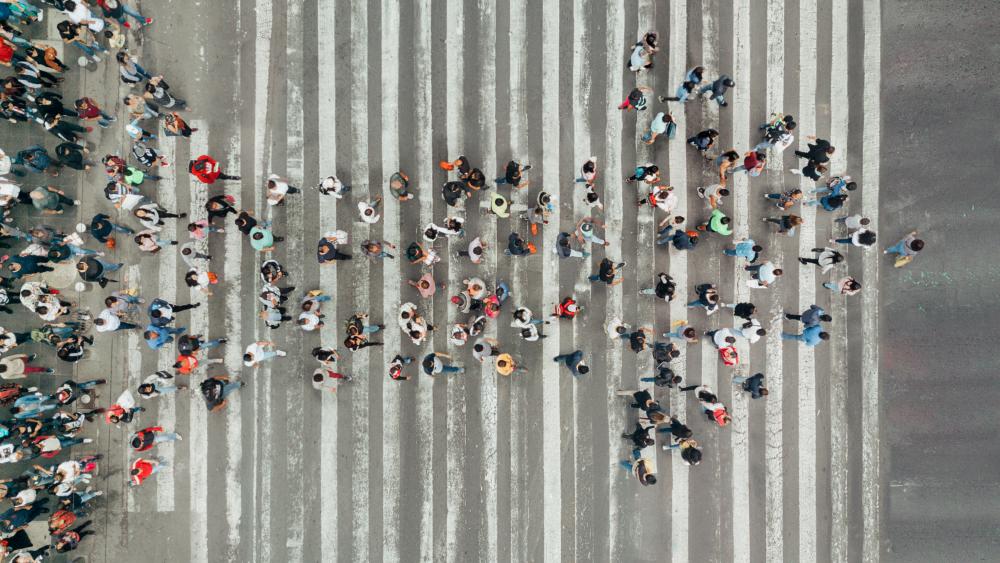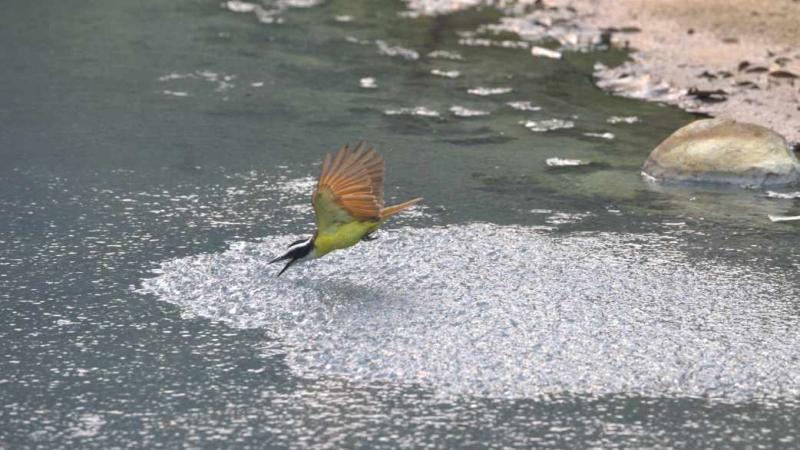
People are adaptable – even when it comes to breaking the rules. | Photo: Orbon Alija on iStock
People are social beings, as are many animal species – fish, for example. Fish are the focus of several research projects at IGB. After all, schools of fish are ideal for studying certain properties of biological systems. Let us take the example of the rapid spread of information: How do fish manage to move synchronously in water, even when the direction of movement changes? This question was investigated by a team comprising IGB’s Mechanisms and Functions of Group-Living research group and researchers from the “Science of Intelligence” Cluster of Excellence at Humboldt-Universität zu Berlin. The researchers were able to prove that fish can anticipate the actions of their conspecifics.

Using a robotic fish, researchers showed that guppies can anticipate the behaviour of their artificial conspecific and predict both the direction and dynamics of its movements. | Photo: David Bierbach
Using a robotic fish, the team showed that guppies can anticipate the behaviour of their artificial conspecific and predict both the direction and dynamics of its movements. The robotic fish always swam the same zigzag path in the experimental tank, ending in one of the corners. This allowed the live fish to learn not only the location of the final target, but also the specific turns of the robot in three consecutive trials: in the third experimental run, they reached the target corner of the robotic fish significantly earlier than the robotic fish itself. “The results show that fish are able to anticipate the behaviour of social partners and even get better at it with training. So this is another explanation for why fish in a school – which know each other well – are capable of extremely fast collective movements,” concluded David Bierbach.
By doing so, the researchers drew a parallel to humans: we know from studies that professionals in ball sports can predict the flight curve or impact location of the ball even before it is thrown or kicked by interpreting various signs such as their fellow players’ postures or body movements. And, in fact, they are able to do this much more effectively than amateurs. Although humans possess an inherent ability to anticipate, this skill can be improved with training and practice.
Optimal information propagation protects against predators
A similar issue was addressed by a team led by HU researcher Luis Gómez-Nava, which also included David Bierbach and Jens Krause. “The study was about whether biological systems reach the state of criticality under certain conditions. This state is characterised by factors such as the optimal spread of information,” explained Jens Krause. To be able to explore this issue, the researchers need a large number of individuals in a small space. They found this condition in a pond in Mexico that is home to swarms of sulphur mollies (Poecilia sulphuraria). “We observed up to 4,000 individuals per square metre, equating to a population of around half a million fish in the entire pond,” reported Jens Krause. In order to breathe, this fish species usually dwells at the water surface, where, however, they risk being attacked by birds. When a bird approaches or attacks, the fish react by diving down collectively, each fish touching the water surface with its tail. The researchers measured the size and propagation of these excitation waves and then fed the field data into a model. The model results confirmed that, in certain phases of high excitability, there is indeed optimal information propagation and, consequently, criticality of the biological system under investigation. The IGB researcher explained that the results cannot be transferred directly to humans, but: “In principle, I think it is conceivable that excitation waves can also spread quickly and widely in large crowds of people.”

Sulphur mollies swim in shoals and behave similarly to a brain that reacts to external stimuli. | Photo: Juliane Lukas
Next, the researchers hope to determine at what times such states of optimal information exchange exist. “Our assumption is that maximum excitability occurs in particular when the fish’s predators are active,” remarked Jens Krause. But this could also be influenced by other factors, such as temperature: in hot weather, the fish need greater energy to dive down into the water, meaning that they may then be less willing to do so.
Collective rule-breaking in animals and humans
These findings also tie in with recent insights into collective rule-breaking, a topic that Jens Krause has published in a review study together with Marcel Brass, Einstein Professor of Social Intelligence at HU Berlin. “For example, we stop at a red light because everyone else does so, and we might cross the road even if the light is red because others are doing the same,” stated Jens Krause, describing a situation in which collective rule-breaking follows collective compliance with rules – both being an expression of social conformity.
From the cognitive side, three processes are particularly important in this respect: distraction, imitation and change of evaluation. “By distraction we mean that individual attention is drawn from the rule to the reaction of others. The group influences perception and directs attention in a particular way. Such influence can inform the individual’s decision to act in accordance with the group,” explained Jens Krause. If we cross a red light because others are doing so, we may be distracted by the group to such an extent that we ignore the light.
Imitation effects describe the phenomenon that people do certain things because others are also doing them. It is a motor cognitive mechanism that happens unconsciously and automatically, whereby the “contagiousness” of rule-breaking increases with group size. “Then there is change of evaluation: we reinterpret the situation based on the behaviour of the group,“ stated Marcel Brass. Two effects are involved here: people perceive a conflict with the group as negative and, on the other hand, experience it as positive when they act together with the group. “As far as negative affect is concerned, research has shown that a different opinion from that of the group triggers a conflict signal in the brain, the dimension of which predicts the extent to which people subsequently change their minds,” the psychologist explained.
Violence as a result of group dynamics
Such behavioural changes reflected real changes in evaluation, according to current research findings. We are not just pretending to make a different decision, we are actually adjusting our decision-making basis for our actions. This can be problematic: “Current scientific consensus is that situational group dynamics are at least necessary and sometimes even sufficient for the outbreak of violence,” reported Jens Krause.
These mechanisms are similar in animals. As in humans, the decision-making dynamics of groups of animals often run non-linearly via quorums: “As soon as a certain number, or a certain percentage, of individuals show a certain behaviour, it is quickly adopted by others,” explained Jens Krause. Even with animals, group behaviour occurs that actually signifies a disadvantage or even a danger to the individual. The study with the robotic fish, for example, shows that a school of fish can indeed be led into the vicinity of a predator by the leader and the group behaviour induced by him – a dangerous situation that an individual fish would not normally put itself in. So fish in a pond and people at traffic lights are not all that dissimilar at times, the IGB researcher concluded.
Individuality is more than just a matter of genes and living conditions
Whether collectivity or conformity, the importance of individuality continues unaffected, and is even reinforced. As such, a team involving David Bierbach and led by IGB researcher Max Wolf was able to show for the first time that genetically identical individuals already differ in their character traits on the first day of life and that these early character differences significantly shape the animals’ behaviour into adulthood.
The researchers studied the behaviour of the Amazon molly (Poecilia formosa). These fish naturally reproduce clonally. The offspring are therefore copies of the mother, meaning that they are genetically identical. Moreover, these fish are live-bearing, and no brood care is involved. This meant that the team, led by Max Wolf, was able to keep newly born Amazon mollies under identical conditions from day one and record their behaviour using a high-resolution tracking system. It was found that strong behavioural individualities are already present on the first day after birth. For example, the fish differ systematically in their activity patterns. These differences in individual behavioural patterns persisted throughout the ten weeks of the experiment and even gradually increased. “This is the first experimental evidence that individuality in later life can be strongly shaped by prenatal factors, such as nourishment in the womb, epigenetics and pre-birth developmental stochasticity,” concluded David Bierbach. Higher organisms can therefore act in a way that is very much in conformity with the group – while remaining highly individual.
Learn more
Why Mexican fish swim the Mexican wave >
Fish schools work a bit like the brain >
Experimental twin research: Personality differences from day one after birth despite identical genes and identical environment >
Here's why the swarm is so fast: its individuals anticipate what the others will do >

Berlin Science Week 2023
The Robo Fish: smart swarms
We invite you to join us: Inspired by the rules that shape swarms of fish and birds, researchers are exploring the complexity of social interactions. The Robo Fish, which we will be showing at Berlin Science Week, integrates itself into groups of live fish, making it possible to study social processes within groups. Steer the Robo Fish yourself and test how well you would act as a "real" fish. Explore collective behaviour and how it relates to robotics and artificial intelligence!
Thursday, 9 November 2023, 6.00 -11.00 pm
Säälchen, Holzmarkt 25, 10243 Berlin






